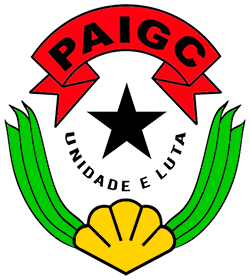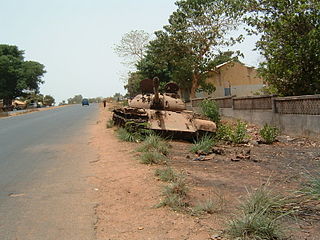| ||||||||||||||||||||||
Do you approve of the new constitution? | ||||||||||||||||||||||
| Results | ||||||||||||||||||||||
|---|---|---|---|---|---|---|---|---|---|---|---|---|---|---|---|---|---|---|---|---|---|---|
| ||||||||||||||||||||||
 |
|---|
A constitutional referendum was held in Guinea on 23 December 1990. The new constitution was approved by 98.7% of voters, with a turnout of 97.4%. [1]
| ||||||||||||||||||||||
Do you approve of the new constitution? | ||||||||||||||||||||||
| Results | ||||||||||||||||||||||
|---|---|---|---|---|---|---|---|---|---|---|---|---|---|---|---|---|---|---|---|---|---|---|
| ||||||||||||||||||||||
 |
|---|
A constitutional referendum was held in Guinea on 23 December 1990. The new constitution was approved by 98.7% of voters, with a turnout of 97.4%. [1]
| Choice | Votes | % |
|---|---|---|
| For | 2,883,156 | 98.68 |
| Against | 38,578 | 1.32 |
| Invalid/blank votes | 5,234 | - |
| Total | 2,926,968 | 100 |
| Registered voters/turnout | 3,004,961 | 97.40 |
| Source: African Elections Database | ||

Equatorial Guinea, officially the Republic of Equatorial Guinea, is a country on the west coast of Central Africa, with an area of 28,000 square kilometres (11,000 sq mi). Formerly the colony of Spanish Guinea, its post-independence name evokes its location near both the Equator and the Gulf of Guinea. As of 2021, the country had a population of 1,468,777.

Guinea, officially the Republic of Guinea, is a coastal country in West Africa. It borders the Atlantic Ocean to the west, Guinea-Bissau to the northwest, Senegal to the north, Mali to the northeast, Cote d'Ivoire to the southeast, and Sierra Leone and Liberia to the south. It is sometimes referred to as Guinea-Conakry after its capital Conakry, to distinguish it from other territories in the eponymous region such as Guinea-Bissau and Equatorial Guinea. It has a population of 13.5 million and an area of 245,857 square kilometres (94,926 sq mi).
The modern state of Guinea did not come into existence until 1958, but the history of the area stretches back well before European colonization. Its current boundaries were determined during the colonial period by the Berlin Conference (1884–1885) and the French, who ruled Guinea until 1958.

Politics of Guinea takes place in a framework of a presidential representative democratic republic, whereby the President of Guinea is both head of state and head of government of Guinea. Executive power is exercised by the government. Legislative power is vested in both the government and the National Assembly.

Guinea-Bissau, officially the Republic of Guinea-Bissau, is a country in West Africa that covers 36,125 square kilometres (13,948 sq mi) with an estimated population of 1,726,000. It borders Senegal to its north and Guinea to its southeast. Guinea-Bissau is the only Portuguese-speaking country in which Muslims make up the majority of its population.
Guinea-Bissau was claimed by Portugal from the 1450s to the 1970s. However, Portuguese control of the region was limited to forts along the coast. Portugal gained full control of the mainland after the pacification campaigns of 1912-15, the offshore Bijago islands weren't colonised until 1936 establishing total control of Guinea-Bissau. Since independence in 1974, the country was controlled by a single-party system until 1991. Following the introduction of multi-party politics in 1991, the first multi-party elections were held in 1994.

The politics of Guinea-Bissau take place in a framework of a semi-presidential representative democratic republic, with a multi-party system, wherein the President is head of state and the Prime Minister is head of government. Executive power is exercised by the government. Legislative power is vested in both the government and the National People's Assembly.

Papua New Guinea, officially the Independent State of Papua New Guinea, is a country in Oceania that comprises the eastern half of the island of New Guinea and its offshore islands in Melanesia. Its capital, located along its southeastern coast, is Port Moresby. The country is the world's third largest island country, with an area of 462,840 km2 (178,700 sq mi).

The politics of Papua New Guinea takes place in a framework of a parliamentary representative democratic multi-party system, whereby the prime minister is the head of government. Papua New Guinea is an independent Commonwealth realm, with the monarch serving as head of state and a governor-general, nominated by the National Parliament, serving as their representative. Executive power is exercised by the government. Legislative power is vested in both the government and parliament.

The governor-general of Papua New Guinea is the vice-regal representative of the Papua New Guinean monarch, currently Charles III, in Papua New Guinea. The governor-general is appointed by the monarch after their nomination by the National Parliament by vote, although the monarch is not bound to accept that nomination for appointment. The functions of the governor-general include appointing ministers, judges, and ambassadors; giving royal assent to legislation passed by parliament; and issuing writs for election.

Lansana Conté was a Guinean politician and military official who served as the second President of Guinea, from 3 April 1984 until his death on 22 December 2008. Conté came to power in the 1984 Guinean coup d'état.

The African Party for the Independence of Guinea and Cape Verde is a political party in Guinea-Bissau. Originally formed to peacefully campaign for independence from Portugal, the party turned to armed conflict in the 1960s and was one of the belligerents in the Guinea-Bissau War of Independence. Towards the end of the war, the party established a socialist one-party state, which remained intact until multi-party democracy was introduced in the early 1990s. Although the party won the first multi-party elections in 1994, it was removed from power in the 1999–2000 elections. However, it returned to office after winning parliamentary elections in 2004 and presidential elections in 2005, since which it has remained the largest party in the National People's Assembly.

João Bernardo "Nino" Vieira was a Bissau-Guinean politician who was the President of Guinea-Bissau from 1980 to 1999, except for a three-day period in May 1984, and from 2005 to 2009.

The Guinea-Bissau Civil War was fought from 7 June 1998 to 10 May 1999 and was triggered by an attempted coup d'état against the government of President João Bernardo Vieira led by Brigadier-General Ansumane Mané. Government forces, backed by neighbouring states, clashed with the coup leaders who had quickly gained almost total control over the country's armed forces.

Guinea elects on the national level a head of state—the president—and a legislature. The president is elected for a five-year term by the people through a two-round system. The National Assembly has 114 members, elected for five-year terms, 38 members in single-seat constituencies and 76 members by proportional representation.

The National Parliament of Papua New Guinea is the unicameral national legislature in Papua New Guinea. It was created in 1964 as the House of Assembly of Papua and New Guinea but gained its current name after the nation was granted independence in 1975.

Alpha Condé is a Guinean politician who served as the fourth president of Guinea from 2010 to 2021.

The unicameral Assemblée nationale or National Assembly is Guinea's legislative body. Since the country's birth in 1958, it has experienced political turmoil, and elections have been called at irregular intervals, and only since 1995 have they been more than approval of a one-party state's slate of candidates. The number of seats has also fluctuated.

The following outline is provided as an overview of and topical guide to Guinea:
Election was a Thoroughbred racehorse that won the 1807 Epsom Derby. His breeder, Lord Egremont, won the Derby for the fourth time with Election. Election raced until he was seven years old and was bought by the Prince Regent after his racing career. He was a successful sire for the Prince's Hampton Court Stud, producing the 1821 Derby winner Gustavus, the 1817 2,000 Guineas Stakes winner Manfred and 1825 1,000 Guineas Stakes winner Tontine.